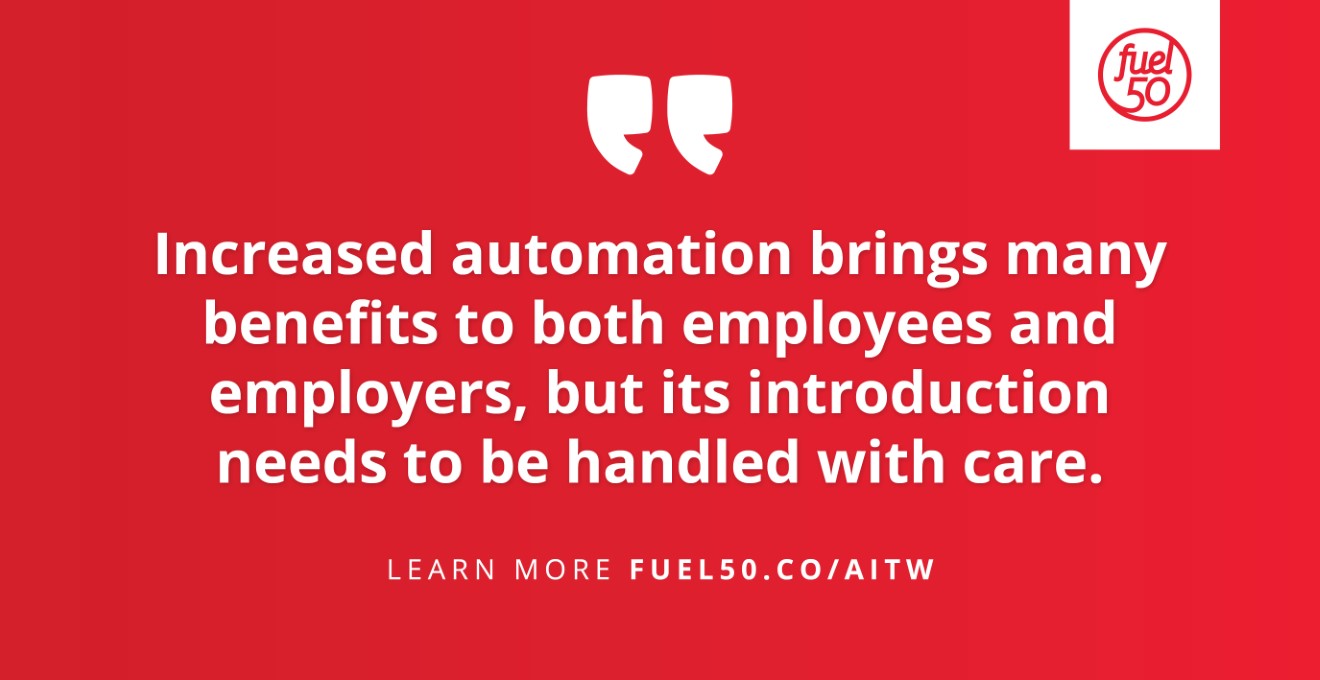We have all fallen prey to predictions of technological advancements that have been proven wrong (like flying cars by the year 2000). And yet, technology continues to evolve at a rate that significantly affects the world of work.
There have been many examples, over the decades, of people thinking automation was eliminating occupations and would continue to do so. However, research conducted in 2015 by a Harvard Economist, James Bessen, proved otherwise. Bessen studied the 270 jobs listed in the 1950’s US census and found that over the last 65 years, 232 of the occupations still existed. According to his research, 32 jobs lost were due to lack of demand, five were due to technical obsolescence, and only one was eliminated (the Elevator Operator)1. So maybe automation is not having such a dramatic effect on job elimination as previously thought?
What is automation?
Automation is when a task performed by a human is seen to be more cost-effective, efficient, or safe if conducted by a machine (robot or Artificial Intelligence). Those more predictive and repetitive tasks in the workplace are ripe for automation. However, those tasks that require human creativity, subjective judgment, and craftsmanship are at low risk for automation. So, what is the overarching trend as automation becomes more prevalent in the workplace? It is job reshaping rather than employee replacing.
The Impact of Covid-19 on automation in the workplace
A study conducted by McKinsey & Company in 20172 stated that: “Automation is happening, and it will bring substantial benefits to businesses and economies worldwide, but it won’t arrive overnight.” Little did they know that the emergence of a global pandemic would change all that.
Covid-19 forced companies to implement measures to reduce workplace infections but also to keep operating costs low. Companies had to look for alternative methods of delivering their products and services to ensure employee safety and business sustainability long-term.
One example of rapid response was Toll Collectors. In those countries where ‘people’ were toll collectors, new solutions were needed to keep both the employees and drivers safe. Many of these countries implemented a tagging system mounted on the windshield or electronic billing based on the vehicle’s license plate. Of course, this contributed to reduced employee risk but also significant job losses.
In 2020, Time Magazine reported that the US had shed about 40 million jobs at the peak of Covid-19, with economists estimating that 42% of those jobs will be gone forever.3
The current predictions for jobs at risk of automation
In 2013, Amazon predicted that they would be delivering all their packages by drone within four to five years. Although they are progressing towards this goal, seven years later, this has not materialized, and the occupation of ‘Couriers’ is still thriving. If we refer to Bessen’s findings, it is expected more jobs will indeed become redundant due to lack of demand or technological obsolescence, but how many is hard to predict. McKinsey & Company stated in their 2017 report2 that “Given currently demonstrated technologies, very few occupations—less than 5 percent—are candidates for full automation.”
Perhaps the future isn’t as bleak as we initially thought. However, it remains important to understand how certain occupations and industries are being reshaped by technological advances.
Research by Philpot in 20204, a leading Career and Entrepreneurship expert, highlighted some occupations expected to change significantly by 2030. These are as follows:
- Travel Agent
- Cashier
- Fast Food Cook
- Mail Carrier / Post Person
- Bank Teller
- Textile Worker
- Printing Press Operator
- Sports Referee / Umpire
- Retail Jeweler
- Dispatcher
- Lumberjack
- Telemarketer
- Fisher
- Legal Secretary
- Assembler / Fabricator

USA TODAY5, one of the top 10 newspaper publications in the US, also published its findings in 2020. They confirmed many of the occupations above and included some additional ones listed below:
- Executive Secretary and Executive Administrative Assistant
- Switchboard Operator
- Watch Repairer
- Word Processor and Typist
- Parking Enforcer
- Locomotive Firer
- Research and Data Entry
The jobs with the highest potential for transformation and the highest risk of automation are those with predictive and repetitive tasks – where human creativity, subjective judgment, and craftmanship form a very small or no part of the responsibilities.
What are some of the benefits to employees of increased automation in the workplace?
A common misconception is that automation will put us all out of a job. However, companies can help build a positive and collaborative human-machine culture with proper education and open communication. Some of the benefits to employees are:
- Enhanced worker safety – automated systems have been attributed to protecting employees against toxic or hazardous working environments such as where toxic materials are stored or where heavy lifting is required.
- Higher morale and decreased turnover – when tedious and repetitive tasks are automated, employees can focus on what they love about their jobs and this, in turn, increases employee satisfaction and decreases turnover.
- Upskilling – automation allows employees to focus on the more meaningful, complex, and creative tasks, which creates opportunities for an employee to upskill. This could lead to taking on more responsibilities and a potential increase in earnings.
- Reduced human error – repetitive tasks often have a higher risk for errors, and we know checking and correcting errors adds additional time and stress to employees. Automating repetitive tasks creates efficiencies, increases the quality of outputs, and reduces the load on employees.
What do employers need to consider when increasing levels of automation in the workplace?
When companies devise their automation strategies, they need to consider the impact on their workforce from both an efficiency and employee perspective. A few key elements for companies to consider are:
- Be transparent: Inform employees of the changes made and how this will affect their day-to-day job. Bring them into the conversation so they are empowered to play an active role in their job reshaping.
- Consider your employee reskilling and upskilling needs: As tasks are eliminated by automation, what could employees start doing to increase the value to your customers or products? Consider employee training needs to make this a reality.
- Create an organizational culture that accepts and seeks out technological advancements: Involve your employees in scoping and the identification of progressive technologies. Foster a culture where the collaboration between humans and machines is important and viewed as critical for ongoing competitive advantage.
What should employees do when faced with increasing automation in the workplace?
Employees have three options when faced with key tasks being automated. They can either support the change, consider their options, or do nothing…
- Support the Change: Employees can support their companies by identifying emerging technologies that can replace some of the mundane and repetitive tasks they perform daily. Bringing this to the attention of key decision-makers can show their commitment to improving organizational processes and productivity, plus gives them a sense of control over the introduction of advanced technologies in their workplace.
- Consider Options: Employees need to start thinking about alternative career options. What careers or roles exist which they can easily transfer into with their current skill set? What do they need to develop to make them even more employable within or across new industries or roles? They need to think big, think ahead, and be proactive in developing new skills.
- Do Nothing: Those employees who do not take charge of exploring future opportunities will be those who are hit the hardest.
It is now more crucial than ever for employees to build transferable skills and to be willing to change careers and career strategies to ensure a long and fulfilled career.
As technology continues to advance at an exponential rate, it will keep shaping and changing the world of work. Increased automation brings many benefits to both employees and employers, but its introduction needs to be handled with care. Employers and employees need to be future-focused and anticipate the impact of automation on their jobs and be open to reskilling and relearning to ensure an engaged workforce and career.
1. Bessen, James E. How Computer Automation Affects Occupations: Technology, Jobs, and Skills (October 3, 2016). Boston Univ. School of Law, Law and Economics Research Paper No. 15-49. Available at https://papers.ssrn.com/sol3/papers.cfm?abstract_id=2690435
2. Manyika, J.; Chui, M.; Miremadi, M.; Bughin, J.; George, K.; Willmott, P. & Dewhurst, M. Harnessing automation for a future that works (January 12, 2017). McKinsey & Company. Available at https://www.mckinsey.com/featured-insights/digital-disruption/harnessing-automation-for-a-future-that-works
3. De la Garza, A, and Zorthian, J. Millions of Americans Have Lost Jobs in the Pandemic—And Robots and AI Are Replacing Them Faster Than Ever (August 17, 2020). TIME MAGAZINE. Available at https://time.com/5876604/machines-jobs-coronavirus/
4. Phillpot, S. 15 Disappearing Jobs that Won’t Exist in 2030 (July 7, 2020). Available at https://www.careeraddict.com/disappearing-jobs
5. Stebbins, S & Grant Suneson, G. Jobs in America: Technology is making these 25 professions start to disappear (November 16, 2020). Available at https://www.usatoday.com/story/money/2020/11/16/jobs-americas-25-disappearing-occupations-technology-effects/43157115/
Written by Fuel50’s Workforce Architecture team
Contributors: Christine Du Plessis
Fuel50’s dedicated team of Workforce Architects and Industrial and Organizational Psychologists feed the Fuel50 Talent Ontology, train our ethical AI with Diversity, Equity, and Inclusion design principles at heart, and support best-in-class organizations using Fuel50 to transform and future-proof their talent strategy and workforce architecture.






